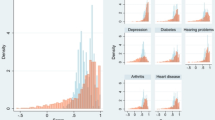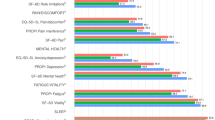Abstract
Choosing between preference-based instruments of health-related quality of life (HR-QOL) in particular situations is an important area for research. Even where instruments can be assumed to be measuring the same thing, they may not be interchangeable. The study presented investigates the extent to which EQ-5D and SF-6D instruments are interchangeable in an older, chronically ill patient group undergoing haemodialysis. Head-to-head comparisons were made using ‘practicality’, ‘descriptive validity’, ‘empirical validity’, mean utilities and associated distributions. Overall it was difficult to choose between instruments on the basis of descriptive or empirical validity, since both performed similarly. Important differences were, however, found relating to practicality: a significantly higher response rate in favour of EQ-5D; and lower levels of missing data to derive health states. Non-response was significantly associated with age and co-morbidity of respondents. We suggest that in patients undergoing haemodialysis, and potentially other older chronically ill patient groups, EQ-5D is the primary preference-based generic HR-QOL instrument.








Similar content being viewed by others
References
Brazier J, Deverill M, Green C, et al. A review of the use of health status measures in economic evaluation. Health Technol Assess 1999; 3(9): 1–164
Brazier J, Roberts J, Tsuchiya A, et al. A comparison of the EQ-5D and SF-6D across seven patient groups. Health Econ 2004 Sep; 13(9): 873–84
Longworth L, Bryan S. An empirical comparison of EQ-5D and SF-6D in liver transplant patients. Health Econ 2003; 12(12): 1061–7
O’Brien BJ, Spath M, Blackhouse G, et al. A view from the bridge: agreement between the SF-6D utility algorithm and the Health Utilities Index. Health Econ 2003; 12(11): 975–81
Conner-Spady B, Suarez-Almazor ME. Variation in the estimation of quality-adjusted-life years by different preference-based instruments. Med Care 2003; 41(7): 791–801
Hawthorne G, Richardson J, Day NA. A comparison of the Assessment of Quality of Life (AQoL) with four other generic utility instruments. Ann Med 2001; 33(5): 358–70
Rabin R, de Charro F. EQ-5D: a measure of health status from the EuroQol Group. Ann Med 2001; 33(5): 337–43
Brooks R, The EuroQol Group. EuroQol: the current state of play. Health Policy 1996; 37(1): 53–72
Brazier J, Usherwood T, Harper R, et al. Deriving a preference-based single index from the UK SF-36 Health Survey. J Clin Epidemiol 1998; 51(11): 1115–28
Ware Jr JE, Snow KK, Kosinski M, et al. SF-36 Health Survey: manual and interpretation guide. Boston (MA): The Health Institute, New England Medical Center, 1993
University of Sheffield. Health Economics and Decision Science SF-6D [online]. Available from URL: http://www.shef.ac.uk/scharr/sections/heds/projects/sf-6d.html [Accessed 2004 Sep 1]
Brazier J, Roberts J, Tsuchiya A. A comparison of the EQ-5D and SF-6D across seven patient groups [online]. Proceedings of the 18th Plenary Meeting of the EuroQol Group; 2001 Sep 6–7; Copenhagen. Available from URL: http://www.euroqol.org/news/meeting2001/proceedings.php [Accessed 2004 Nov 3]
Wight JP, Edwards L, Brazier J, et al. The SF36 as an outcome measure of services for end stage renal failure. Qual Health Care 1998; 7(4): 209–21
Churchill DN, Torrance GW, Taylor DW, et al. Measurement of quality of life in end-stage renal disease: the time trade-off approach. Clin Invest Med 1987; 10(1): 14–20
De Wit GA, Ramsteijn PG, De Charro FT. Economic evaluation of end stage renal disease treatment. Health Policy 1998; 44(3): 215–32
Roderick P, Nicholson T, Mehta R, et al. An evaluation of the costs and effective-ness of and quality of care of renal replacement therapy provision in renal satellite units in England and Wales. Health Technol Assess. In press
Kennedy C, Oxoby R, Donaldson C. Marginal contingent valuation: an empirical test. San Francisco (CA): International Health Economics Association (iHEA) 4th World Congress, 2003
Fitzpatrick R, Davey C, Buxton MJ, et al. Criteria for assessing patient based outcome measures for use in clinical trials. In: Stevens A, Abrams K, Brazier J, et al., editors. The advanced handbook of methods in evidence based healthcare. London: SAGE Publications, 2001: 181–94
Brazier J, Deverill M. A checklist for judging preference-based measures of health related quality of life: learning from psychometrics. Health Econ 1999; 8(1): 45–51
Kind P, Hardman G, Macran S. UK population norms for EQ-5D [discussion paper no. 172]. York: Centre for Health Economics, University of York, 1999
Brazier J, Roberts J, Deverill M. The estimation of a preference-based measure of health from the SF-36. J Health Econ 2002; 21(2): 271–92
Whynes D, Neilson A. Convergent validity of two measures of the quality of life. Health Econ 1993; 2: 229–35
Kind P, Gudex C. Measuring health status in the community: a comparison of methods. J Epidemiol Community Health 1994; 48: 86–91
Karnofsky D, Burcherval J. The clinical evaluation of chemotherapeutic agents in cancer. In: Macleod C, editor. New York: Columbia University Press, 1949
Charlson ME, Pompei P, Ales KL. A new method of classifying prognostic comorbidity in longitudinal studies: development and validation. J Chronic Dis 1987; 40(5): 373–83
SPSS for Windows [11.5.0]. Chicago (IL): SPSS Inc, 2002
Intercooled Stata 7.0 for Windows 98/95/NT [7.0]. College Station (TX): Stata Corporation, 2002
Bland JM, Altman DG. Statistical methods for assessing agreement between two methods of clinical measurement. Lancet 1986; I(8476): 307–10
Altona DG. Practical statistics for medical research. London: Chapman & Hall, 1991
Acknowledgements
We are grateful to the other members of the National Renal Satellite Evaluation Group, patients and hospital staff from the 24 units that participated in the study. We are also grateful for comments received at a Health Economists’ Study Group meeting and from Professor Gavin Mooney. The NHS R&D Health Technology Assessment Programme funded the project. The views expressed in this paper and any errors are those of the authors alone. There are no conflicts of interest relevant to this article.
Author information
Authors and Affiliations
Corresponding author
Appendices
Appendices
Appendix 1
Refer to table A1.
Appendix 2
Refer to table A2.
Appendix 3: Details of Statistical Analyses
Weighted Kappa scores tested the level of agreement for the first set of construct validity tests. Following standard practice five categories of agreement were used to interpret the Kappa scores: ‘poor’ =<0.2; ‘fair’ =0.21-0.4; ‘moderate’ = 0.41−0.6; ‘good’ =0.61−0.8; and 0.81−1.0 = ‘very good’.[29] These interpretations were also applied to the correlation coefficients.
The Chi-square test of association was used for categorical data; the Mann-Whitney U test to compare two groups; and the Jonckheere-Terpestra test to assess trends for ordered categorical data. Given that multiple statistical tests were undertaken, even those found to be statistically significant need cautious interpretation.
A Bonferroni correction was not used as this might have been overly conservative in what was an exploratory study.
Rights and permissions
About this article
Cite this article
Gerard, K., Nicholson, T., Mullee, M. et al. EQ-5D versus SF-6D in an older, chronically ill patient group. Appl Health Econ Health Policy 3, 91–102 (2004). https://doi.org/10.2165/00148365-200403020-00005
Published:
Issue Date:
DOI: https://doi.org/10.2165/00148365-200403020-00005






